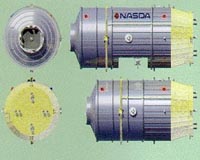 |
Pasadena CA (SPX) Sep 11, 2009 Sniffing out any potential contaminants on the International Space Station where it was stationed for the last six months, the JPL-built electronic nose, or ENose, is homeward bound. While on the space station, the ENose sampled the air with 32 sensors that can detect various odors and pinpoint which ones are dangerous to humans. The sleek, shoebox-sized ENose, the third generation of its kind, monitored the air for 10 contaminants continuously. "Our six-month test went very well. The ENose identified formaldehyde, Freon 218, methanol and ethanol, but all of them were at harmless levels," said Amy Ryan, principal investigator of the ENose at NASA's Jet Propulsion Laboratory, Pasadena, Calif. Ryan built the ENose at JPL and has managed the project from its early beginnings in 1996. "An instrument like this could one day remain on the Space Station and monitor air quality in real-time." In the future, the ENose could be used in monitoring crew cabins for vehicles to the moon and other destinations or be stationed on a moon base. Other potential applications include detecting a smoldering fire before it erupts, sniffing for unexploded land mines and monitoring for chemical spills in a work area. There are also possible applications in medical diagnosis. "A human nose is not always as sensitive to chemicals as the ENose and our noses cannot even detect some hazardous chemicals," said Ryan. "The ENose can smell trouble and give people advance warning before contamination levels cause harm." The ENose was flown to the International Space Station by the Space Shuttle Endeavour STS-126 mission in December 2008. It is set to return home on the Space Shuttle Discovery STS-128, after its 13-day flight.
Share This Article With Planet Earth
Related Links ENose Station at NASA Station and More at Roscosmos S.P. Korolev RSC Energia Watch NASA TV via Space.TV Space Station News at Space-Travel.Com
 Japan sends first cargo spacecraft to ISS
Japan sends first cargo spacecraft to ISSTokyo (AFP) Sept 11, 2009 Japan early Friday launched its first cargo spacecraft to the International Space Station, aiming for a share of space transport after the retirement of the US space shuttle fleet next year. The Japan Aerospace Exploration Agency (JAXA) launched the unmanned H-II Transfer Vehicle (HTV) atop an H-IIB rocket, which is also on its first flight, as scheduled just after 2:00 am (1700 GMT Thursday ... read more |
|
| The content herein, unless otherwise known to be public domain, are Copyright 1995-2009 - SpaceDaily. AFP and UPI Wire Stories are copyright Agence France-Presse and United Press International. ESA Portal Reports are copyright European Space Agency. All NASA sourced material is public domain. Additional copyrights may apply in whole or part to other bona fide parties. Advertising does not imply endorsement,agreement or approval of any opinions, statements or information provided by SpaceDaily on any Web page published or hosted by SpaceDaily. Privacy Statement |